小学英语听课笔记整理
- 格式:docx
- 大小:23.31 KB
- 文档页数:8
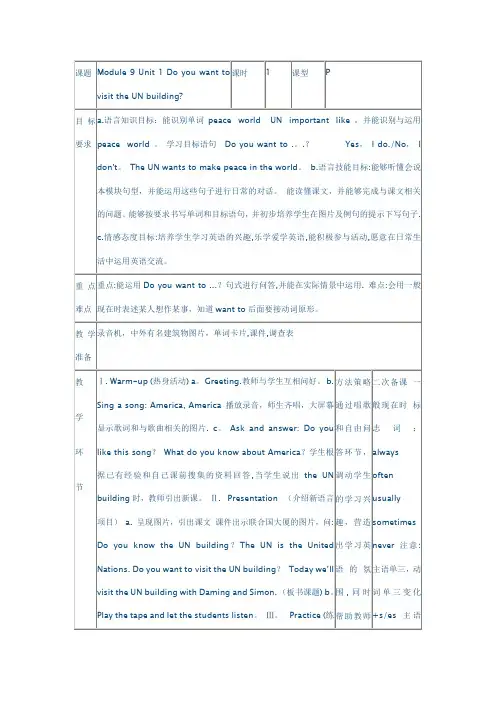
习) a. 操练“want to"句子 1.Listen again and find the sentences with “want to"。
教师再次播放录音,学生边听边找出含有“want to”的句子,划出来。
2。
Read the sentences you find 。
教师请学生读自己找到的句子(共3句),学生读一句,大屏幕出示一句。
3. 教师问学生:Do you want to visit the UN building ? 让学生回答Yes , please 。
问学生还可以怎样回答,学生会答Yes ,I do 。
教师和学生做一个传话游戏。
T : Do you want to visit the UN building ? S1: Yes , please.或者回答 Yes,I do.(Turn to another student.) Do you want to visit the UN building ? S2: Yes , please 。
这名同学做跟刚才第一个同学相同的事。
S3: 。
.。
4.课件出示联合国大厦和各国国旗的图片,说:There are so many flags in the UN 。
Many countries are in the UN 。
The UN wants to make peace in the world 。
5。
指读第3句带有want to 的句子Do you want to go inside the UN building ? 全班齐读齐回答. b 。
教授新单词 1.大屏幕出示这句话The UN wants to make peace in the world.教peace 的发音,ea 发[i :] 的音,c 发[s ] 的音,让学生读(指读,小组读,男女读)。
问学生还有哪个单词中ea 发[i:] 的音。
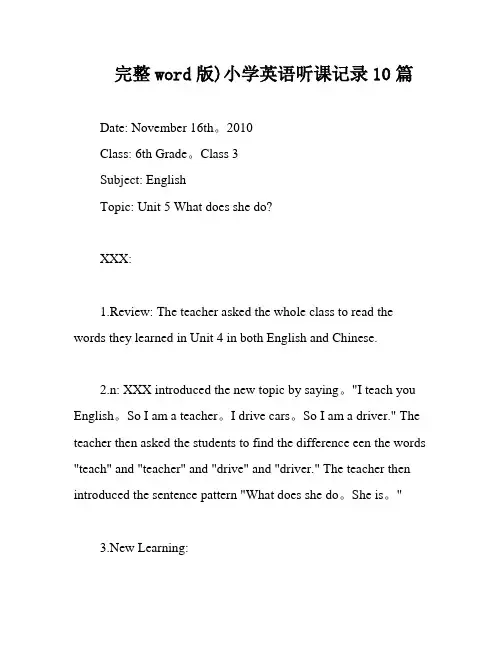
完整word版)小学英语听课记录10篇Date: November 16th。
2010Class: 6th Grade。
Class 3Subject: EnglishTopic: Unit 5 What does she do?XXX:1.Review: The teacher asked the whole class to read the words they learned in Unit 4 in both English and Chinese.2.n: XXX introduced the new topic by saying。
"I teach you English。
So I am a teacher。
I drive cars。
So I am a driver." The teacher then asked the students to find the difference een the words "teach" and "teacher" and "drive" and "driver." The teacher then introduced the sentence pattern "What does she do。
She is。
"3.New Learning:a。
"I sing songs。
I am a singer." The teacher asked the students to XXX word "singer." The teacher then asked the students if they XXX pattern "What does he/she do。
He/she is。
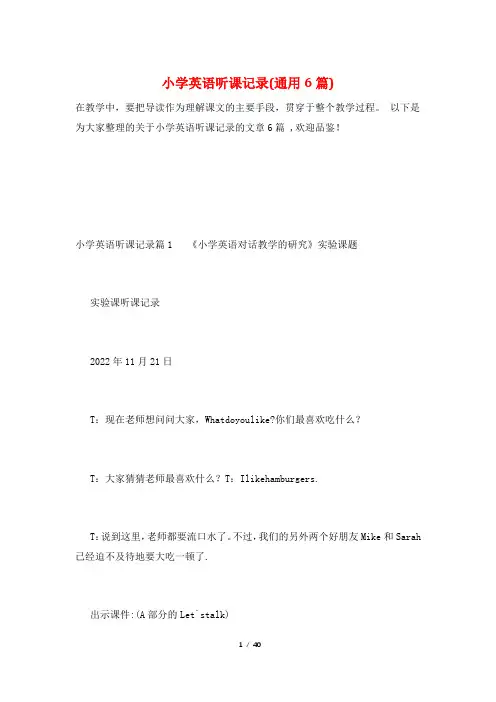
小学英语听课记录(通用6篇)在教学中,要把导读作为理解课文的主要手段,贯穿于整个教学过程。
以下是为大家整理的关于小学英语听课记录的文章6篇 ,欢迎品鉴!小学英语听课记录篇1 《小学英语对话教学的研究》实验课题实验课听课记录2022年11月21日T:现在老师想问问大家,Whatdoyoulike?你们最喜欢吃什么?T:大家猜猜老师最喜欢什么?T:Ilikehamburgers.T:说到这里,老师都要流口水了。
不过,我们的另外两个好朋友Mike和Sarah 已经迫不及待地要大吃一顿了.出示课件:(A部分的Let`stalk)第一组对话:Ilikehamburgers.Ilikehotdogs.T:Mike喜欢吃 Sarah喜欢吃 Whataboutyou?T:OK,now,readafterit.(读两遍)自主练习。
T:Whatdoyoulike?你喜欢吃什么?指名同学回答。
T:Continue.继续看。
第二组对话:Hereyouare.Hotdogsandhamburgers.T:好了,香喷喷的汉堡包和热狗终于来了,让我们再一次看看服务员阿姨是怎么说的?T:Whocaeadit?Haveatry!T:Ok,让我们一起读。
T:老师也很喜欢.Hotdogsandhamburgers.不过,Mike非常能吃,他觉得汉堡包和热狗还不够,我们看看,他又点了些什么?出示第三组对话:IlikeFrenchfries.Metoo.T:Ok,nowwhocaeadit?Haveatry!找学生试读,教师加以纠正。
T:哪一组愿意读给大家听一听。
Haveatry!找两组同学试读。
T:Ilikehamburgers.如果你也喜欢hamburgers,用同样的方法操练chicken、bread、cake、hotdogs.出示第四组对话:Ok,havesomeFrenchfries.Thankyou.T:好了,现在我们可以张开大嘴,开吃了。
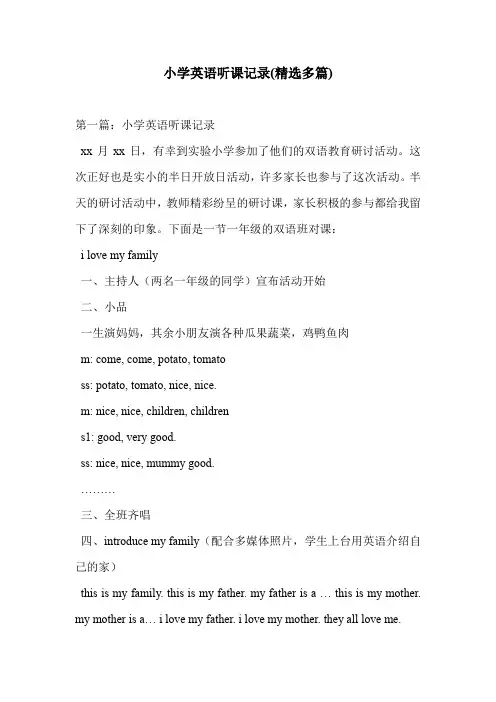
小学英语听课记录(精选多篇)第一篇:小学英语听课记录xx月xx日,有幸到实验小学参加了他们的双语教育研讨活动。
这次正好也是实小的半日开放日活动,许多家长也参与了这次活动。
半天的研讨活动中,教师精彩纷呈的研讨课,家长积极的参与都给我留下了深刻的印象。
下面是一节一年级的双语班对课:i love my family一、主持人(两名一年级的同学)宣布活动开始二、小品一生演妈妈,其余小朋友演各种瓜果蔬菜,鸡鸭鱼肉m: come, come, potato, tomatoss: potato, tomato, nice, nice.m: nice, nice, children, childrens1: good, very good.ss: nice, nice, mummy good.………三、全班齐唱四、introduce my family(配合多媒体照片,学生上台用英语介绍自己的家)this is my family. this is my father. my father is a … thi s is my mother. my mother is a… i love my father. i love my mother. they all love me.五、say a rhymei love my dad, this is my dad. dad, dad, my dad. i love my dad. (mummy)六、draw a picture for our parents, say i love you to them.学生把作好的卡片送给父母七、小品:the garbage outside the window八、sing a song: the more we get together九、flash: merry christmas 教师送学生礼物对于刚接触英语三个多月的学生来说,开展这样一次双语班会实在不容易。
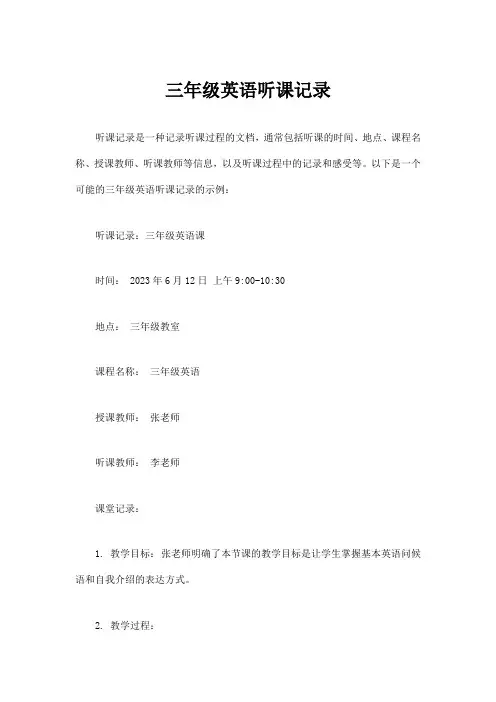
三年级英语听课记录
听课记录是一种记录听课过程的文档,通常包括听课的时间、地点、课程名称、授课教师、听课教师等信息,以及听课过程中的记录和感受等。
以下是一个可能的三年级英语听课记录的示例:
听课记录:三年级英语课
时间: 2023年6月12日上午9:00-10:30
地点:三年级教室
课程名称:三年级英语
授课教师:张老师
听课教师:李老师
课堂记录:
1. 教学目标:张老师明确了本节课的教学目标是让学生掌握基本英语问候语和自我介绍的表达方式。
2. 教学过程:
* 张老师通过歌曲和游戏引入课程,激发学生的学习兴趣。
* 通过图片和示范,引导学生模仿并练习英语问候语。
* 学生分组进行自我介绍对话练习,鼓励学生大胆开口。
* 利用多媒体资源,播放英语短片,让学生接触真实语境。
3. 课堂互动:张老师经常与学生进行互动,鼓励他们回答问题和参与讨论,课堂氛围较为活跃。
4. 教学评价:张老师及时给予学生正面的反馈和指导,对学生的学习情况进行跟踪和记录。
5. 教学难点处理:当学生在发音和表达上遇到困难时,张老师耐心纠正,并引导学生通过模仿和实践来改进。
感受与建议:
* 张老师的课堂组织能力较强,能够很好地吸引学生的注意力。
* 建议张老师在今后的教学中,更多地利用生活中的实际情境来帮助学生理解和运用英语。
* 学生的参与度较高,但部分学生在发音和语法方面仍需加强练习。
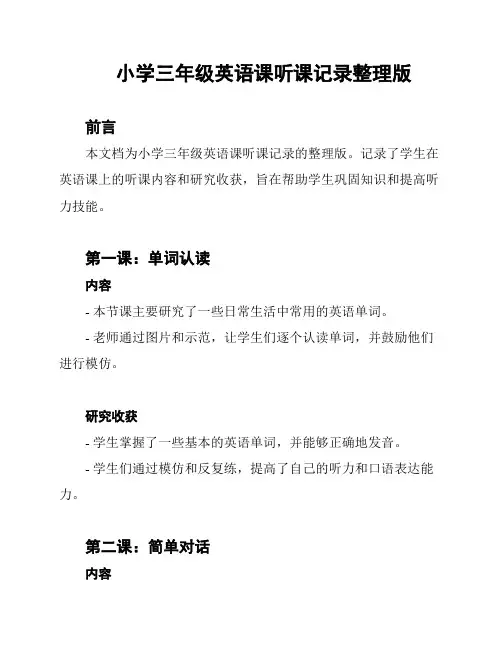
小学三年级英语课听课记录整理版前言本文档为小学三年级英语课听课记录的整理版。
记录了学生在英语课上的听课内容和研究收获,旨在帮助学生巩固知识和提高听力技能。
第一课:单词认读内容- 本节课主要研究了一些日常生活中常用的英语单词。
- 老师通过图片和示范,让学生们逐个认读单词,并鼓励他们进行模仿。
研究收获- 学生掌握了一些基本的英语单词,并能够正确地发音。
- 学生们通过模仿和反复练,提高了自己的听力和口语表达能力。
第二课:简单对话内容- 本节课研究了如何进行简单的英语对话。
- 学生们分组进行对话练,互相提问和回答问题,加强了英语口语交流能力。
研究收获- 学生通过与同学的对话练,提高了自己的表达和倾听能力。
- 学生们对一些日常生活中常用的对话进行了研究和掌握。
第三课:阅读理解内容- 本节课研究了如何进行简单的阅读理解。
- 学生们通过阅读短文,回答问题,培养了自己的阅读和理解能力。
研究收获- 学生通过阅读短文,锻炼了自己的阅读理解能力。
- 学生们学会了从文章中寻找关键信息来回答问题,提高了自己的阅读效率和准确性。
第四课:听力训练内容- 本节课研究了通过听力训练来提高自己的听力技巧。
- 学生们在老师的引导下,仔细听音频材料,并完成相应的听力练。
研究收获- 学生们通过大量的听力训练,提高了对英语听力材料的理解能力。
- 学生们学会了辨别不同的语音语调,加强了与外国人进行语言交流的信心。
总结通过记录和整理这些听课内容,我们可以看到学生们在英语课上的研究收获和进步。
他们通过研究单词、对话和阅读,以及听力训练,不仅提高了英语能力,还增强了自己的自信心和英语研究动力。
相信在以后的研究中,他们会更加努力,取得更好的成绩。
以上为小学三年级英语课听课记录的整理版。
希望这份文档对学生们的学习有所帮助。
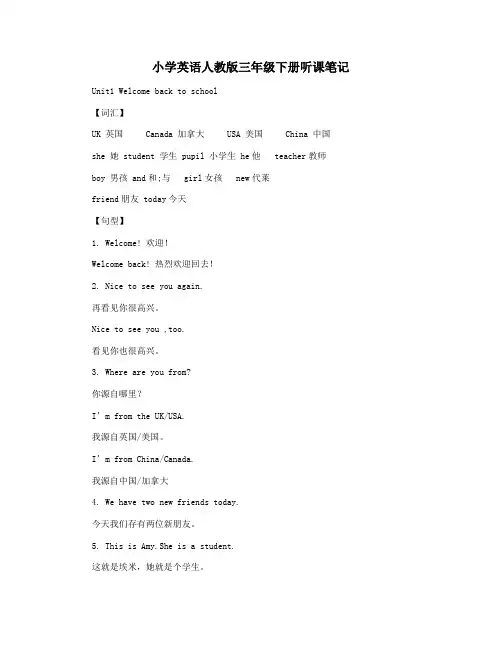
小学英语人教版三年级下册听课笔记 Unit1 Welcome back to school【词汇】UK 英国Canada 加拿大USA 美国China 中国she 她 student 学生 pupil 小学生 he他 teacher教师boy 男孩 and和;与 girl女孩 new代莱friend朋友 today今天【句型】1. Welcome! 欢迎!Welcome back! 热烈欢迎回去!2. Nice to see you again.再看见你很高兴。
Nice to see you ,too.看见你也很高兴。
3. Where are you from?你源自哪里?I’m from the UK/USA.我源自英国/美国。
I’m from China/Canada.我源自中国/加拿大4. We have two new friends today.今天我们存有两位新朋友。
5. This is Amy.She is a student.这就是埃米,她就是个学生。
6. This is MR Jones. He is a teacher.这就是琼斯先生,他就是一位教师。
Unit2 My family【词汇】father父亲;爸爸dad (口语) 爸爸;爹爹 man男人woman 女人mother母亲;妈妈 sister 姐;妹 brother 兄;弟 grandmother (外)祖母 grandma (口语)(外)祖母 grandfather(外)祖父grandpa (口语)(外)祖父family家;家庭【句型】1. Who’s that man? He is my father.那个男人就是谁?他就是我爸爸。
2. Who’s that woman? She is my mother.那个女人就是谁?她就是我妈妈。
3. Who’s that boy? He is my brother.那个男孩就是谁?他就是我哥哥。
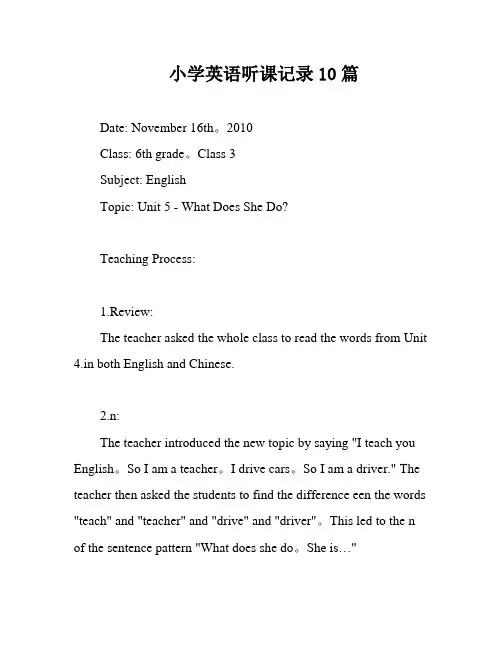
小学英语听课记录10篇Date: November 16th。
2010Class: 6th grade。
Class 3Subject: EnglishTopic: Unit 5 - What Does She Do?Teaching Process:1.Review:The teacher asked the whole class to read the words from Unit 4.in both English and Chinese.2.n:The teacher introduced the new topic by saying "I teach you English。
So I am a teacher。
I drive cars。
So I am a driver." The teacher then asked the students to find the difference een the words "teach" and "teacher" and "drive" and "driver"。
This led to the n of the sentence pattern "What does she do。
She is…"3.New Content:a。
"I sing songs。
I am a singer." The teacher asked the students to guess the meaning of the sentence and introduced the word "singer"。
The teacher then asked the students if they knew any singers and practiced the sentence pattern "What does he/she do。
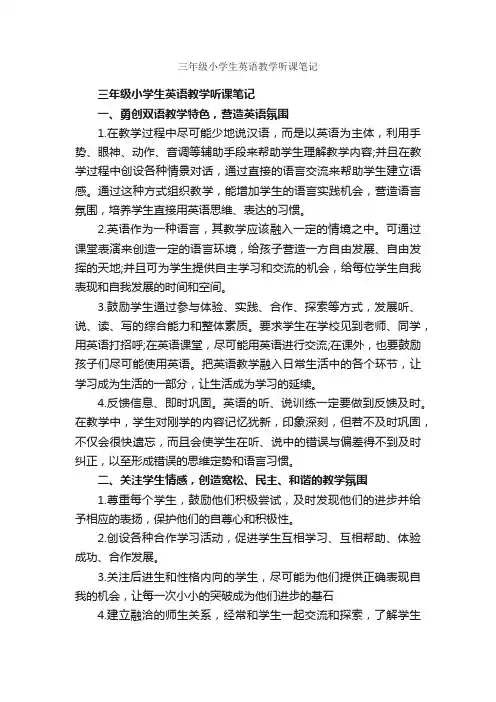
三年级小学生英语教学听课笔记三年级小学生英语教学听课笔记一、勇创双语教学特色,营造英语氛围1.在教学过程中尽可能少地说汉语,而是以英语为主体,利用手势、眼神、动作、音调等辅助手段来帮助学生理解教学内容;并且在教学过程中创设各种情景对话,通过直接的语言交流来帮助学生建立语感。
通过这种方式组织教学,能增加学生的语言实践机会,营造语言氛围,培养学生直接用英语思维、表达的习惯。
2.英语作为一种语言,其教学应该融入一定的情境之中。
可通过课堂表演来创造一定的语言环境,给孩子营造一方自由发展、自由发挥的天地;并且可为学生提供自主学习和交流的机会,给每位学生自我表现和自我发展的时间和空间。
3.鼓励学生通过参与体验、实践、合作、探索等方式,发展听、说、读、写的综合能力和整体素质。
要求学生在学校见到老师、同学,用英语打招呼;在英语课堂,尽可能用英语进行交流;在课外,也要鼓励孩子们尽可能使用英语。
把英语教学融入日常生活中的各个环节,让学习成为生活的一部分,让生活成为学习的延续。
4.反馈信息、即时巩固。
英语的听、说训练一定要做到反馈及时。
在教学中,学生对刚学的内容记忆犹新,印象深刻,但若不及时巩固,不仅会很快遗忘,而且会使学生在听、说中的错误与偏差得不到及时纠正,以至形成错误的思维定势和语言习惯。
二、关注学生情感,创造宽松、民主、和谐的教学氛围1.尊重每个学生,鼓励他们积极尝试,及时发现他们的进步并给予相应的表扬,保护他们的自尊心和积极性。
2.创设各种合作学习活动,促进学生互相学习、互相帮助、体验成功、合作发展。
3.关注后进生和性格内向的学生,尽可能为他们提供正确表现自我的机会,让每一次小小的突破成为他们进步的基石4.建立融洽的师生关系,经常和学生一起交流和探索,了解学生所想所需,做到教学相长。
小学生英语教学听课笔记-2[/page]三、加强学习方法指导,帮助学生学会学习1.积极创造条件,让每个学生都参与到学习活动中来。
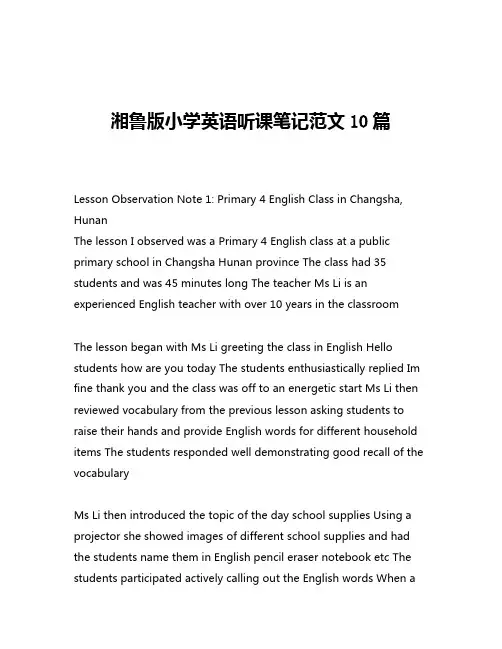
湘鲁版小学英语听课笔记范文10篇Lesson Observation Note 1: Primary 4 English Class in Changsha, HunanThe lesson I observed was a Primary 4 English class at a public primary school in Changsha Hunan province The class had 35 students and was 45 minutes long The teacher Ms Li is an experienced English teacher with over 10 years in the classroomThe lesson began with Ms Li greeting the class in English Hello students how are you today The students enthusiastically replied Im fine thank you and the class was off to an energetic start Ms Li then reviewed vocabulary from the previous lesson asking students to raise their hands and provide English words for different household items The students responded well demonstrating good recall of the vocabularyMs Li then introduced the topic of the day school supplies Using a projector she showed images of different school supplies and had the students name them in English pencil eraser notebook etc The students participated actively calling out the English words When astudent had difficulty Ms Li would provide the word and have the class repeat after herNext Ms Li distributed worksheets with pictures of school supplies and asked the students to write the English words corresponding to each item The students worked quietly and diligently on this task moving from picture to picture Students who finished early were encouraged to help their classmates The energy in the classroom was focused and on-taskTo wrap up the lesson Ms Li had several students come to the front and use the school supplies on the desk to model sentences such as This is a pencil or I have a notebook The students spoke clearly and confidently demonstrating their understandingOverall this was a well-structured lesson that effectively reviewed prior learning introduced new vocabulary and provided opportunities for students to actively practice using English The pace was brisk the teacher engaged the class well and the students were attentive and participated enthusiastically I was impressed by the students English proficiency and the teachers skilled facilitation of the lessonLesson Observation Note 2 Primary 5 English Class in Jinan ShandongI observed a Primary 5 English class at a well-regarded public primary school in Jinan Shandong province The class had 40 students and the lesson was 45 minutes long The teacher Mr Wang is considered one of the top English teachers in the districtMr Wang began the lesson by having the students sing an English song about the days of the week The students sang with energy and enthusiasm clearly enjoying the activity After the song Mr Wang asked several students what day of the week it was today The students replied confidently in EnglishMr Wang then launched into the main part of the lesson which focused on teaching new vocabulary related to hobbies Using flashcards he introduced words like play chess read books go hiking play basketball etc asking the students to repeat each word after him The students participated actively eager to learn the new vocabularyNext Mr Wang put the students into pairs and had them practice making simple sentences using the new hobby words For example one student might say I like to play chess and the other student would respond Thats great I like to read books The students chatted animatedly in English helping each other and providing encouragementTo assess learning Mr Wang called on individual students to come tothe front of the class and draw a hobby from a box then make a sentence about it The students did this with ease demonstrating a solid grasp of the new vocabulary and sentence structureMr Wang concluded the lesson by having the class review all the new hobby words as a group He was pleased with their progress and encouraged them to continue practicing English at home The students left the class energized and smilingI was very impressed by the high level of English proficiency demonstrated by the Primary 5 students They spoke confidently handled new vocabulary quickly and seemed to genuinely enjoy the English lesson Mr Wang was an engaging and skilled teacher who clearly had strong rapport with his students and effective classroom management strategiesLesson Observation Note 3 Primary 3 English Class in Zhuzhou HunanToday I had the opportunity to observe a Primary 3 English class at a public primary school in Zhuzhou Hunan province The class had 32 students and the lesson was 45 minutes long The teacher Mrs Chen is a young but very dynamic English teacherMrs Chen began the lesson with a warm-up activity She greeted the students in English and asked how they were doing The studentsreplied enthusiastically Mrs Chen then led the class in singing an English song about colors which they seemed to enjoyMoving into the main part of the lesson Mrs Chen introduced the topic of animals using colorful flashcards She showed an image of a dog for example and asked the students to say the English word dog The students called out the word in unison Mrs Chen repeated it and had the class say it again ensuring they were pronouncing it correctlyNext Mrs Chen put the students into pairs and had them practice simple dialogues about animals For instance one student might say I have a cat at home and the other student would respond Thats nice I have a dog Mrs Chen circulated around the classroom listening in and providing feedbackTo check understanding Mrs Chen called on individual students to come to the front of the class and describe an animal in English One student said I have a goldfish it is orange and swims in the water The class listened attentively and applauded when the student finished speakingMrs Chen concluded the lesson by reviewing all the animal vocabulary words the class had learned She praised the students for their hard work and engagement then reminded them to continue practicing English at home The students left the classroom chattingexcitedly in English about the animals they had learnedI was struck by the students enthusiasm and willingness to participate actively in the English lesson Mrs Chen did an excellent job of creating an engaging atmosphere keeping the students focused and motivated throughout the class Her use of flashcards pair work and individual activities effectively reinforced the vocabulary learningLesson Observation Note 4 Primary 6 English Class in Qingdao ShandongThis morning I had the chance to observe a Primary 6 English class at a top-performing public primary school in Qingdao Shandong province The class had 42 students and the lesson was 45 minutes long The teacher Mr Li is known as one of the most experienced and skilled English teachers in the districtMr Li began the class by reviewing homework from the previous lesson He called on several students to share their answers to the practice exercises The students responded confidently in English demonstrating a solid grasp of the materialMr Li then introduced the topic of the day which was reading comprehension Using a projected text he guided the students through a short passage about a family vacation askingcomprehension questions along the way The students followed along attentively and volunteered answers when called uponTo provide more practice Mr Li divided the class into small groups and had them read another short passage together discussing the key details in English Each group then selected a representative to summarize the passage for the class The students engaged actively with each other and presented their summaries wellTowards the end of the lesson Mr Li gave the students a short quiz to assess their understanding of the reading comprehension skills covered in the lesson The students worked independently completing the quiz questions before Mr Li went over the answers as a classMr Li wrapped up the lesson by highlighting the key vocabulary and reading strategies the students had practiced He praised them for their hard work and engagement then reminded them to continue reading English texts at home to build their skillsOverall this was an extremely well-structured and effective English lesson The pace was brisk but not rushed Mr Li kept the students engaged through a variety of activities and provided ample opportunities for them to practice their English reading and speaking skills I was impressed by the high level of English proficiencydemonstrated by the Primary 6 studentsLesson Observation Note 5 Primary 4 English Class in Changde HunanThis afternoon I had the pleasure of observing a Primary 4 English class at a public primary school in Changde Hunan province The class had 38 students and the lesson was 45 minutes long The teacher Mrs Xu is a seasoned English educator with over 15 years of experienceMrs Xu began the lesson by greeting the students in English and asking how they were doing The students responded with enthusiasm Mrs Xu then led the class in a quick warm-up activity reviewing vocabulary related to food and drinks The students participated actively calling out the English wordsNext Mrs Xu introduced the topic of the day which was talking about daily routines Using a series of flashcard images she prompted the students to say sentences like I wake up at 7 oclock or I brush my teeth before bed The students demonstrated solid command of the vocabulary and sentence structuresTo provide more practice Mrs Xu divided the class into pairs and had them take turns sharing what they do each morning or evening in simple English sentences The students conversed animatedly helping each other and laughing together as they described their dailyroutinesTowards the end of the lesson Mrs Xu called on individual students to come to the front of the class and draw a daily routine activity from a box then describe it to the class The students presented confidently in English delighting in sharing the details of their daily livesMrs Xu concluded the lesson by highlighting the key vocabulary and grammar points the students had practiced She praised their engagement and English skills then encouraged them to continue speaking English at home with their families The students left the classroom chatting excitedlyI was very impressed by the students level of English proficiency and comfort speaking the language They participated actively throughout the lesson demonstrating solid vocabulary knowledge and sentence-level fluency Mrs Xu was an experienced and skilled teacher who clearly had excellent rapport with her students and used a variety of engaging activities to support their learningLesson Observation Note 6 Primary 5 English Class in Qingdao ShandongThis morning I had the opportunity to observe a Primary 5 English class at a high-performing public primary school in QingdaoShandong province The class had 41 students and the lesson was 45 minutes long The teacher Ms Zhang is known as one of the top English teachers in the districtMs Zhang began the lesson with a warm-up activity reviewing vocabulary related to hobbies The students enthusiastically called out the English words when Ms Zhang displayed the corresponding flashcards It was clear they had mastered this vocabulary from previous lessonsMs Zhang then introduced the topic of the day which was talking about weekend activities Using a projector she displayed images of different weekend activities like going to the park reading a book or playing sports For each image she prompted the students to create a sentence describing what they seeThe students worked in pairs taking turns describing the weekend activities they observed in the images Ms Zhang circulated around the classroom listening in and providing feedback when needed The students conversed animatedly in English helping each other form grammatically correct sentencesTowards the end of the lesson Ms Zhang called on several students to come to the front of the class and describe one of the weekend activities to the group The students presented confidently sharingdetailed sentences about what they liked to do on the weekendsTo wrap up the lesson Ms Zhang reviewed the key vocabulary and grammar points the students had practiced She praised them for their excellent participation and English skills then encouraged them to keep speaking English at home with their families The students left the classroom chatting excitedly about their weekend plansI was very impressed by the high level of English proficiency demonstrated by the Primary 5 students They spoke confidently used a wide range of vocabulary and handled complex sentence structures with ease Ms Zhang was a highly skilled and engaging teacher who created a positive learning environment and effectively reinforced the students language skillsLesson Observation Note 7 Primary 3 English Class in Changsha HunanThis afternoon I had the pleasure of observing a Primary 3 English class at a public primary school in Changsha Hunan province The class had 33 students and the lesson was 45 minutes long The teacher Ms Chen is a young but enthusiastic English teacherMs Chen began the lesson by greeting the students in English and asking how they were The students replied cheerfully in English demonstrating good comprehension Ms Chen then led the class insinging an English song about animals which they seemed to enjoyTransitioning into the main part of the lesson Ms Chen used flashcards to introduce new animal vocabulary words like lion elephant giraffe and monkey She showed each card pronouncing the word clearly and having the students repeat after her The students participated actively eager to learn the new wordsNext Ms Chen put the students into pairs and had them practice simple dialogues about animals For instance one student might say I have a dog at home and the other student would respond Thats nice I have a cat Ms Chen circulated around the classroom listening in and providing feedback when neededTo assess learning Ms Chen called on individual students to come to the front of the class and describe an animal in English One student said I have a goldfish it is orange and swims in the water The class listened attentively and applauded when the student finished speakingMs Chen concluded the lesson by reviewing all the animal vocabulary the class had learned She praised the students for their hard work then reminded them to continue practicing English at home The students left the classroom chattering excitedly in English about their favorite animalsI was impressed by the students enthusiasm and willingness to participate actively in the English lesson Ms Chen did an excellent job of keeping them engaged through a variety of activities and maintaining a positive learning environment Her use of flashcards pair work and individual presentations effectively reinforced the new vocabularyLesson Observation Note 8 Primary 6 English Class in Yiyang Hunan This morning I had the opportunity to observe a Primary 6 English class at a public primary school in Yiyang Hunan province The class had 39 students and the lesson was 45 minutes long The teacher Mr Wu is a seasoned English educator with over 20 years of experienceMr Wu began the class by reviewing homework from the previous lesson He called on several students to share their answers to the practice exercises demonstrating their mastery of the material covered in the last class The students responded confidently in EnglishMr Wu then introduced the topic of the day which was reading comprehension Using a projector he displayed a short passage about a family trip and guided the students through it asking comprehension questions along the way The students followed along attentively and volunteered answers when called uponTo provide more practice Mr Wu divided the class into small groups and had them read another passage together discussing the key details in English Each group then selected a representative to present a summary to the class The students engaged actively with each other and delivered their presentations skillfullyTowards the end of the lesson Mr Wu gave the students a short quiz to assess their understanding of the reading comprehension strategies covered in the lesson The students worked independently completing the quiz questions before Mr Wu reviewed the answers as a classMr Wu wrapped up the lesson by highlighting the key vocabulary and reading skills the students had practiced He praised them for their hard work and engagement then encouraged them to continue reading English texts at home to further develop their abilitiesI was very impressed by the high level of English proficiency demonstrated by the Primary 6 students They displayed strong reading comprehension skills handled new vocabulary with ease and spoke confidently when summarizing passages Mr Wu was a highly experienced and effective teacher who maintained an engaging pace and used a variety of activities to support student learningLesson Observation Note 9 Primary 5 English Class in Weifang ShandongThis afternoon I had the privilege of observing a Primary 5 English class at a public primary school in Weifang Shandong province The class had 36 students and the lesson was 45 minutes long The teacher Ms Li is considered one of the top English teachers in the districtMs Li began the class by greeting the students in English and asking how their day was going The students responded enthusiastically in English demonstrating good comprehension Ms Li then led the class in a quick warm-up activity reviewing vocabulary related to transportationNext Ms Li introduced the topic of the day which was describing transportation methods Using images displayed on a projector she prompted the students to create sentences like I ride my bike to school or My family takes the bus to work The students participated actively calling out the English sentencesTo provide more practice Ms Li put the students into pairs and had them take turns sharing how they typically get to different places For example one student might say I walk to the park and the other student would respond I ride my scooter to the store The students conversed animatedly helping each other form grammatically correctsentencesTowards the end of the lesson Ms Li called on individual students to come to the front of the class and draw a transportation method from a box then describe how they use it The students presented confidently in English describing their daily commutes with enthusiasmMs Li concluded the lesson by reviewing the key vocabulary and grammar points the students had covered She praised their excellent participation and English skills then encouraged them to continue speaking English at home The students left the classroom chatting excitedly about their favorite ways to travelI was very impressed by the students high level of English proficiency and comfort speaking the language They participated actively throughout the lesson demonstrating solid vocabulary knowledge and sentence-level fluency Ms Li was a skilled and engaging teacher who used a variety of activities to effectively support the students learningLesson Observation Note 10 Primary 4 English Class in Jinan ShandongThis morning I had the chance to observe a Primary 4 English class at a public primary school in Jinan Shandong province The class had 42students and the lesson was 45 minutes long The teacher Mr Zhang is known as one of the most experienced and effective English teachers in the districtMr Zhang began the class by greeting the students in English and asking how they were feeling The students responded with energy and enthusiasm demonstrating good comprehension Mr Zhang then led the class in singing an English song about the weather which they seemed to enjoyTransitioning into the main part of the lesson Mr Zhang used flashcards to introduce new vocabulary words related to weather like sunny cloudy rainy and snowy He pronounced each word clearly and had the students repeat after him to practice the pronunciation The students participated actively eager to learn the new wordsNext Mr Zhang put the students into pairs and had them practice simple dialogues about the weather For instance one student might say Its sunny today and the other student would respond Thats great I love sunny weather Mr Zhang circulated around the classroom listening in and providing feedback when neededTo check understanding Mr Zhang called on individual students to come to the front of the class and describe the weather One student said Its cloudy today the clouds are grey and it looks like it mightrain soon The class listened attentively and applauded when the student finished speakingMr Zhang concluded the lesson by reviewing all the weather vocabulary the class had learned He praised the students for their hard work and engagement then reminded them to continue practicing English at home especially by talking about the weather The students left the classroom chattering excitedly in English about their favorite types of weatherI was impressed by the students enthusiasm and strong grasp of the English language Mr Zhang was a highly skilled and experienced teacher who used a variety of。
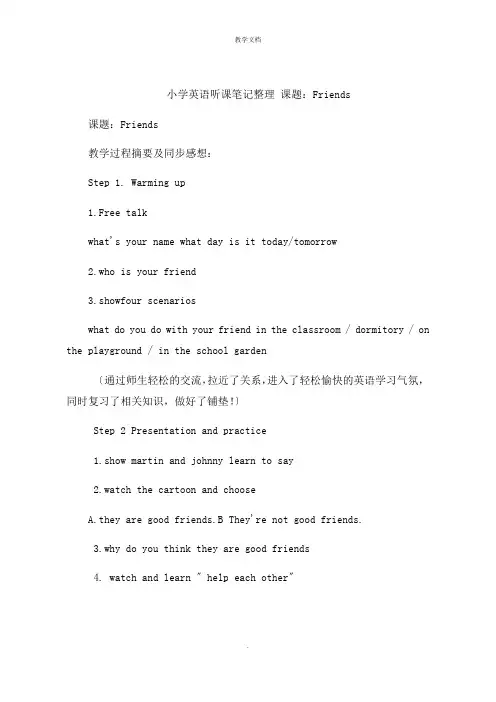
小学英语听课笔记整理课题:Friends课题:Friends教学过程摘要及同步感想:Step 1. Warming up1.Free talkwhat's your name what day is it today/tomorrow2.who is your friend3.showfour scenarioswhat do you do with your friend in the classroom / dormitory / on the playground / in the school garden〔通过师生轻松的交流,拉近了关系,进入了轻松愉快的英语学习气氛,同时复习了相关知识,做好了铺垫!〕Step 2 Presentation and practice1.show martin and johnny learn to say2.watch the cartoon and chooseA.they are good friends.B They're not good friends.3.why do you think they are good friends4. watch and learn 〞help each other〞Try to saywhen i( ),my friend( 〕5. watch and chooseA johnny helps martinBjohnny goes awaydiscusswhen you do something ,what does our friend do for us6.watch and chooseA martin shares the choclate withjohnnyBmartin eats thechoclate himself〔以A,B剧的形式引领学生分析所学内容,自然地呈现彬彬个操练了重点知识,而且注重思维能力的训练,结合恰当的设问激发了学生的思维欲望,启迪了智慧!〕7.when you have something nice , do you often share with your friend?8.read the passage to have feeling〔配上了悠扬的音乐,让学生用心聆听,唤醒感情,带着感情朗读,很是享受!〕Step 3 consolidation and extension1.播放悠扬的音乐,呈现好友们校园里三三两两的活动场景。
小学三年级英语听课笔记:It' s too big for you听课记录Step 1、Warming-up1、Greetings.2、Revision教师出示图片并运用:What, sthis?来提问,引导学生用:It' sa…It' s…来回答。
Step 2、Presentation1、Leading-in出示多媒体,教师创设Lingling回中国的情境引出本课课题。
(板书课题)2、Listen and answer.多媒体出示与课文相关的问题,学生听录音再回答。
3、Look、listen and say.(1)、多媒体呈现图片,教师引导学生说句子:There is a T-shirt. But itt s too big for him. There is a football. Can he play football? No, it' s too hard for him.(2)、板书:It' s…for…并带读。
4、利用图片学习句型。
教师出示课件,学生根据课件表达句子:Lingling buys a red cap and a dress for her friends.2、Game.请2位学生示范:一个表演动作,另一个猜。
必须用:It' s…for…来表达。
3、生一起朗读,师板书。
Step 5、Homework板书设计Module 5 Book 6Unit 2 It' s too big for you.It'1、教学情境有创新,能更好地激发学生的学习兴趣.2、将知识与现实生活联系起来,让学生明白所学的知识就是来源于生活。
3、教学互动的设计能让学生亲身参与,促进了学生自主地去学习新知。
小学英语六年级听课记录14篇打包目录1. 第一篇:《家庭成员》2. 第二篇:《我的学校》3. 第三篇:《我的日常生活》4. 第四篇:《我的爱好》5. 第五篇:《食物与饮料》6. 第六篇:《交通工具》7. 第七篇:《四季与天气》8. 第八篇:《节日与庆祝活动》9. 第九篇:《动物世界》10. 第十篇:《身体部位与健康》11. 第十一篇:《时间与日历》12. 第十二篇:《地理与文化》13. 第十三篇:《职业与梦想》14. 第十四篇:《旅行与探险》第一篇:《家庭成员》- 时间:2021年3月1日- 地点:教室- 主要内容:研究关于家庭成员的词汇和句子,如爸爸、妈妈、哥哥、姐姐等。
- 收获:学生们能够准确地描述自己的家庭成员,用英语简单介绍家庭情况。
第二篇:《我的学校》- 时间:2021年3月5日- 地点:教室- 主要内容:研究描述学校事物和活动的词汇和句子,如教室、课程、运动场等。
- 收获:学生们能够用英语简单描述自己的学校环境、研究生活和校园活动。
第三篇:《我的日常生活》- 时间:2021年3月10日- 地点:教室- 主要内容:研究描述日常活动的词汇和句子,如起床、吃早餐、上学等。
- 收获:学生们能够用英语简单描述自己的日常生活和常见活动。
...(以下省略)第十四篇:《旅行与探险》- 时间:2021年6月20日- 地点:教室- 主要内容:研究与旅行和探险相关的词汇和句子,如旅游、山脉、沙滩等。
- 收获:学生们能够用英语描述自己的旅行经历和梦想,表达对探险活动的兴趣。
以上是小学英语六年级听课记录的14篇打包。
这些记录涵盖了家庭成员、学校、日常生活、爱好、食物与饮料、交通工具、四季与天气、节日与庆祝活动、动物世界、身体部位与健康、时间与日历、地理与文化、职业与梦想、旅行与探险等主题。
通过这些课程,学生们能够提高英语听力和口语能力,丰富词汇量,培养对英语研究的兴趣。
感谢您的阅读!。
小学五年级英语上册听课记录第一课:打招呼- 课程内容:学生研究如何用英语进行常见的打招呼和问候- 授课时间:2021年9月1日- 授课教师:王老师- 上课笔记:- 通过图片和口头练,学生学会了如何用英语问候他人。
- 学生分组进行角色扮演,模拟实际场景中的打招呼对话。
- 教师通过示范和指导,帮助学生纠正发音和语调。
第二课:自我介绍- 课程内容:学生研究如何用英语进行自我介绍- 授课时间:2021年9月3日- 授课教师:张老师- 上课笔记:- 教师首先向学生展示了一个范例自我介绍,并解释了每句话的意思。
- 学生们分组进行互相介绍,用英语描述自己的基本信息。
- 教师逐个点评学生的表达,鼓励并纠正他们的语法错误。
第三课:数字和计数- 课程内容:学生研究如何用英语表达数字和进行计数- 授课时间:2021年9月5日- 授课教师:李老师- 上课笔记:- 教师通过展示数字卡片,帮助学生熟悉英语中的基本数字。
- 学生们进行数字的听写练,巩固数字的记忆。
- 教师介绍了计数的方式,并给学生提供了练题让他们运用所学进行计数。
第四课:家庭成员- 课程内容:学生研究如何用英语表达家庭成员- 授课时间:2021年9月7日- 授课教师:刘老师- 上课笔记:- 教师向学生展示了家庭成员的图片,并教授了相关的英语表达。
- 学生们用英语介绍自己家庭成员,并说出他们的关系。
- 教师为学生提供了一些家庭成员的谜语,让学生猜测并用英语回答。
第五课:动物世界- 课程内容:学生研究如何用英语表达常见的动物名称- 授课时间:2021年9月9日- 授课教师:赵老师- 上课笔记:- 教师通过展示图片,向学生介绍了不同种类的动物,并教授了相应的英语单词。
- 学生们模仿教师的发音,尝试用英语说出不同动物的名称。
- 教师让学生们进行游戏,通过听到的动物声音猜测对应的动物名称。
以上是小学五年级英语上册的部分听课记录,每一课都涵盖了不同的主题和学习内容。
通过这些听课记录,我们可以看到学生们在英语学习中的进步和成果。
【导语】不要说⼀天的时间⽆⾜轻重,⼈⽣的漫长岁⽉就由这⼀天⼀天连接⽽成;愿你珍惜⽣命征途上的每⼀个⼀天,让每天都朝⽓蓬勃地向前进。
以下是为⼤家整理的《⼩学五年级英语听课笔记》供您查阅。
练⼀练:It's twelve o'clock. It's time __ ___.A. for breakfastB. for lunchC. for supperD.to lunch上海版⽜津⼩学英语:5B Module 3 Unit 1 学习笔记Module 3 Things around usUnit 1 SignsVocabulary:telephone 电话 toilet 卫⽣间restaurant 餐馆 exit 出⼝entrance ⼊⼝ No smoking! 禁⽌吸烟!No swimming! 禁⽌游泳! Don't litter! 禁⽌乱丢垃圾!Don't walk on the grass! 禁⽌践踏草坪!Sentences:[例]What does this sign mean? It means we can't play football here.What does this sign say? It says we mustn't walk on the grass.练⼀练:What___ this sign mean?A. areB. doC. doesD. is上海版⽜津⼩学英语:5B Module 3 Unit 2 学习笔记Module 3 Things around usUnit 2 WeatherVocabulary:cloud 云 cloudy 多云的sun 太阳 sunny 有阳光的,晴天的rain ⾬,⾬滴 rainy ⾬天的,下⾬的wind 风 windy 有风的snow 雪 snowy 下雪的storm 暴风⾬ stormy 暴风⾬的fog 雾 foggy 有雾的30°C / thirty digrees 30 摄⽒度Sentences:对话练习:-What's the weather like today?-It's rainy.-I don't like the rain. I like sunny weather.-It was rainy yesterday. It's windy today. The wind is blowing strongly.-That's great. I like windy weather. I want to fly my kite.练⼀练:Yesterday ___ a ___day. I went to Zhongshan Park with my grandparents. We are happy.A. is, sunnyB. was, rainyC. was, sunnyD. were, rainy上海版⽜津⼩学英语:5B Module 3 Unit 3 学习笔记Module 3 Things around usUnit 3 ChangesVocabulary:bookshelf 书架 mirror 镜⼦cushion 垫⼦ cupboard 橱柜lamp 台灯 sofa 沙发furniture 家具 next (to) 紧挨着give 给 move 移动window 窗户 wall 墙Sentences:上海版⽜津⼩学英语:5B Module 1 Unit 1 学习笔记 Module1 Using my five sensesUnit 1 What a messVocabulary:school bag 书包 brush 刷⼦,画笔,⽑笔 paints 绘画颜料 crayon 蜡笔,有⾊粉笔 notebook 笔记本 glue 胶⽔tape 胶带 put 放,安置Sentences:Whose ...?It's / They're mine / yours / his /hers / ours / theirs例句:-Whose T-shirt is this?-It's mine.-Is that T-shirt yours too, Peter?-No, it's Danny's练⼀练:-___ball is this? -It's ___A. What, PaulB. What, Paul'sC. Whose, PaulD. Whose, Paul's。
人教pep上册听课笔记人教pep上册是小学一年级英语教材,共12个单元,涵盖了学习英语的基础知识和基本技能。
本文将概括讲述每个单元的内容和重点。
第一单元介绍了英语学习的基本规则和学习方法。
通过这个单元,学生可以了解到英语中的字母和数字,同时学会了一些日常用语,例如问候语和自我介绍。
第二单元围绕着学校的日常生活展开。
学生将学习一些学校里常见的物品和场所的名称,并且学会了表达时间和日常活动的句子。
第三单元主要讲述家庭成员和家具的介绍。
通过学习这个单元,孩子们可以更好地了解家庭内部的人员构成,以及家具的名称。
同时,通过讲述家庭成员间的关系,培养孩子们的亲情观念。
第四单元介绍了食物和饮品的名称。
通过这个单元的学习,学生可以学会一些日常用语,例如询问和点餐,同时也可以了解不同的食物种类和制作方式。
第五单元围绕着句子的构成展开。
学生将学习构造英语简单句的基本要素,例如主语、谓语和宾语。
通过这个单元的学习,可以提升学生的语言组织能力。
第六单元讲述了一些常见的动物名称和特点。
通过学习这个单元,学生可以了解到不同的动物种类和它们的特点,同时也可以学会用英语描述不同动物。
第七单元主要介绍了一些世界各地的风俗和节日。
学生将学习到一些不同的文化,了解不同国家的习俗和传统。
通过这个单元的学习,可以增加学生的文化素养。
第八单元围绕着天气和季节展开。
学生将学习一些常见的天气状况和季节的名称,并且学会用英语表达不同的天气情况。
通过这个单元的学习,可以帮助学生更好地了解天气变化,提高他们的观察能力。
第九单元主要讲述了交通工具和交通规则。
学生将学习一些交通工具的名称,并且了解一些基本的交通规则。
通过这个单元的学习,可以培养学生的安全意识和交通常识。
第十单元围绕着身体部位展开。
学生将学习一些身体部位的名称,并且学会用英语表达不同的身体感受和健康状况。
通过这个单元的学习,可以培养学生的健康观念。
第十一单元介绍了一些常见的颜色和形状。
学生将学习一些颜色和形状的名称,并且学会用英语描述不同的颜色和形状特征。
小学英语听课笔记整理一、以下观念是否正确?1. 兴趣第一:只要学生有兴趣,就一定能学好。
()分析:持续的、好学乐学的兴趣才可以,而表面兴趣不行。
笔者思考:严格来讲,表面兴趣不是兴趣,只是好奇心而已。
我们教师要把学生的这种短暂的好奇心转变成持续的兴趣。
这需要我们课上课下都要认真去做。
2.教师至上:( )笔者思考:应该以学生为主体。
商业服务中讲顾客是上帝、顾客至上。
与之类似,在我们教师心中,学生是上帝,学生至上。
你的教育在学生身上体现出良好的效果了,你的教育才是成功的。
一堂课下来学生从中不仅学到了知识,而且提高了能力,甚至情感文化意识得到了提升,那么这堂课才是成功的。
3.熟能生巧:只要学生多做练习,成绩就会提高。
( )笔者思考:这是现行教育体制的弊端导致的。
成绩也许会提高,但是能力情感观念方面未必得到提升。
另外,这里指的练习要看是哪种类型的了。
举个极端的例子:把你放在美国,完全是讲英语的环境中,那也也算是一种听说的练习,这种练习当然会使你的英语水平提高很快了。
所以,这句话在以前的观念中的含义当然是不可取的,而我们可以从中受到的启发是:我们要多给学生在英语环境中练习运用英语的机会,使他们的成绩提高、能力提升。
二、外语教学观念的演变传统教学:重点在教会知识――英语语言知识(语法词汇翻译)。
(一维教学目标)改革开放以后:重点在培养语言技能——知识+技能(听说读写译)。
(二维教学目标)近几年:重点在培养综合素质——知识+技能+学习策略、文化意识、情感态度。
(三维教学目标)三、教学方案设计的意义1、教学方案设计是教师必须具备的基本功之一2、教学方案设计是展示教师个性化和创造性过程的纪录3、教学方案设计是教师教的行为和学生学的方式的点子库。
教学方案的价值不仅仅是课堂教学的准备,教学方案是作为教师的教学思想、教学轨迹的记录,也是教师认识自己、总结经验、成长提高的重要资料。
『基本理念一』一、实施课改的关键是什么?实施课改重在转变教学思想和教学方法,改革传统的课堂教学模式。
因此,推进课改的关键是从理论层面变成课堂教学具体操作的框架,研制出符合信课程标准的、既高效又易于操作的课堂教学新模式。
课程标准——符合课表精神的理念——课堂教学的实际操作二、对课堂教学理论上的认识教学过程市教学学生学习的过程,重要的是让学生参与知识的构建过程的探究学习,发展学生的认知结构,训练学生的思维能力,使其成为懂得如何处理学习问题的学习者,获得主动探究知识和自主学习的能力,为其终身学习打下基础。
三、有效学习1、有效学习必须在社会环境中互动。
2、有效学习是学习者在学习任务中的互动。
分析一:做中学——Learning English by doing things (Learning by doing)例:学What’s your name?的问答时,给自己起新名字,同伴之间相互调查。
分析二:强调学习过程1、认知重构:新知识是与原有经验、知识相互作用而建构的。
2、情境认知:知识是在具体情境中,在实践活动中建构的。
3、社会互动:知识是在与人交往中,在重要他人中介作用下建构的。
对学习者来说,与教师交流时,重要他人是老师;小组活动中,重要他人是小组同伴。
笔者补充:建构主义学习理论教师要创设情境,激发学生主动获取知识的欲望。
例:设置到商店买东西,第一个学会的先上来买。
学生自然就很想知道问多少钱怎么说。
此时学生的注意力是最集中的,学习的欲望非常强。
笔者所受启发:在3A My schoolbag 中,也可以采取这种方式,先学会问What’s in your schoolbag?的同学可以先上来问,并且来查看包中物品。
教师可以让学生摸一摸,然后来猜。
然后打开包验证。
学生忘记了的时候教师可以小声提示,或用口型,使学生的注意力高度集中。
会的人数多了以后可以小组进行设置悬念互相问答。
课堂教学设计的目标突出知识形成过程,突出学生探究的活动,使学习的过程成为学生形成积极的情感态度、主动思维和大胆实践,形成自主学习能力的过程。
教师的职责:1、帮助学生明确学习目标,唤起学生学习的渴望。
2、帮助学生设计恰当的学习活动3、帮助学生利用学习资源。
分析:学习资源包括卡片、录音、课本、教具、学具等。
例如录音,每次听都有任务,由易到难。
书:阅读,浏览Q1——细读Q2——细读某一段Q3笔者所受启发:在3A My schoolbag 中,设计听力训练,听录音,Q1、录音中涉及到哪些物品?Q2录音中的人物在干什么?(即发生了什么事情?)Q3、有几支铅笔?几支钢笔?几把尺子?[1][2][3][4]下一页教学方案设计的策略1、让学生学会什么本领?(教学目标)2、让学生做什么事?(教学活动设计)3、学生能从你设计的活动中获得什么?(教学活动的有效性)设计前的思考1、什么情况下,学生学得最好?(1)当学生有兴趣时。
(2)当学生的身心处于最佳的状态时(3)当教学内容能用多种形式来呈现时。
(例:Magic Bag Teacher)很多形式,每次都不一样。
笔者思考:让学生每次都有期待。
(4)当学生遇到理智的挑战时(跳一跳,摘到果子)(5)当学生发现知识的个人意义时(体验到学了有用)(6)当学生有安全感时(7)当学生有成就感时课堂学生活动设计1、为什么进行课堂学生活动设计(设计目标)2、怎样进行课堂学生活动设计(设计方法)3、组织:分组\分工\角色(过程)4、学生活动形式5、学生活动产出(output)(效果)6、学生活动评价教学设计中常见问题1、目标不明确(丢能力大目标,围单词转)2、难点把握不准(未突破难点,了解学生学什么的时候是难点)例:教mouth。
看看我的嘴巴有什么特点?舌头有什么特点?你做给老师看。
同桌检查画老鼠mouse在黑板上,告诉学生嘴巴读错了就成了老鼠了。
3、活动设计的目标性不强。
4、活动形式体现参与率不够。
5、活动之间缺乏递进的层次性。
6、活动设计程式化,缺乏创新意识。
7、重知识、轻能力现象。
(简单的开火车读就是如此)可用语言使其显示能力8、听说活动多,读写活动弱。
(盲人英语)9、缺乏评价方案设计。
10、板书设计不好,或书写不认真,不能给学生做一个好榜样。
教学方案设计的原则1、以学生为主体的原则2、体现学生学习过程的原则3、体现认知规律的原则4、体现形成性评价的原则教学过程设计要体现1、巧:引入要独具匠心,过渡自然2、活:教法灵活,训练模式多变3、实:目标明确,过程简洁易操作教学方案设计程序1、分析教学内容与学生现状2、教学目标(三维)3、重点难点4、构思达标途径(任务活动链)5、设计具体教学活动(任务)(充分利用教具、板书、练习、课件)6、设计具体教学评价方案7、设计家庭作业例:抄句子作业,不如组成chant,并美化它。
或者让学生自己改编。
教学方案设计总任务:引导学生完成目标达标途径:采取的步骤方式1、热身复习活动Warm up2、呈现新知活动Presentation3、新知操练活动Practice4、扩展运用活动Production5、总结归纳活动Warm up1.Warming up 热身活动设计(1)设计目标:营造氛围+复习铺垫+引入新课(2)设计形式:动Songs, Chants, TPR activities, Conversation, Show interview & report, Games静Brain storming, Memory games, Guessing games, Categeries, Watch and think (Let’s start.)注意:1、设计与话题紧密联系的活动2、设计能调动记忆库存的活动3、设计能自然引入新课的活动4、设计短小精悍的活动(3~5分钟)2.Presentation 新知呈现活动设计(1)目标:感知+理解+初步记忆(2)形式:看图听力理解;带着问题看课件、vcd、dvd;玩偶表演笔者提示:这里少很多内容,没记上,欢迎补充。
注意:1.活动设计要有利于集中注意力2.要减轻学生焦虑以及教学难度3、突破难点4、由易及难,层层递进5、环环相扣,自然过渡例:left,right,军乐队,问:转几次?生观看。
3、新知(1)目标:记忆+巩固+运用(2)形式:机械+意义 1.机械操练:目的:模仿、记忆、巩固新知形式:Games,Song/Chant/看图替换例:侦察兵游戏。
选出侦察兵,背对同学,选出间谍,生齐说句子,间谍只动嘴不出声,侦察兵找出间谍。
笔者思考:类似于hide and seek游戏。
是突破单词或句子发音难点的好方法。
2.意义操练:目的:交际运用新知要求:必须是有信息差的交际游戏活动。
信息差information gap:我知你不知,你知我不知。
笔者所受启发:练习what’s in the schoolbag?时,学会的同学上来问,老师让他摸,(设置一些容易摸出来的物品)。
他摸出来以后小声耳语告诉老师。
对了老师认可,不对再摸。
后面的同学摸出来以后小声告诉已经知道的同学,来求验证。
小组活动:一个同学准备物品,余生问,该生让其他同学猜,然后摸,然后说出来。
形式:交际性游戏Gussing games,What’s in the ……?Where’s/Where are……?(hide and seek),Find the differenct(找区别),Match and ask your parter(生自己连,构成不同的情境,有信息差,同伴问),调查表……4、扩展运用(1)目的:扩展运用新语言+培养综合运用能力(2)形式:运用语言的任务型活动:真实情况了解与交流、调查、采访等模拟真实任务型游戏活动例:看地图,找路线,交流。
(3)注意:1.把握扩展的度(a little)2.综合运用所学语言5.Wrap up 总结活动(1)目标:整合知识+评价效果+布置延伸活动(2)形式:What have you got in this class?Self check,Make a report/chant/songs.编或演,Tasks课堂延伸性活动例:课前先布置听天气预报,下节课汇报。
课前设计+课中调整+课后反思听说读写都可以设计成任务1.Read and choose the correct answer.2. Role-play (ordering food at a restaurant)3. Interview (on spare time actives)4. Listen to a weather forecast and make a report5. Read the story are suggest a different ending6. Act the dialogize7.听录音排乱图8.描绘照片9、打电话10、做卡片任务设计原则目的性、趣味性、灵活性、参与性、层次性、激励性、可操作性。